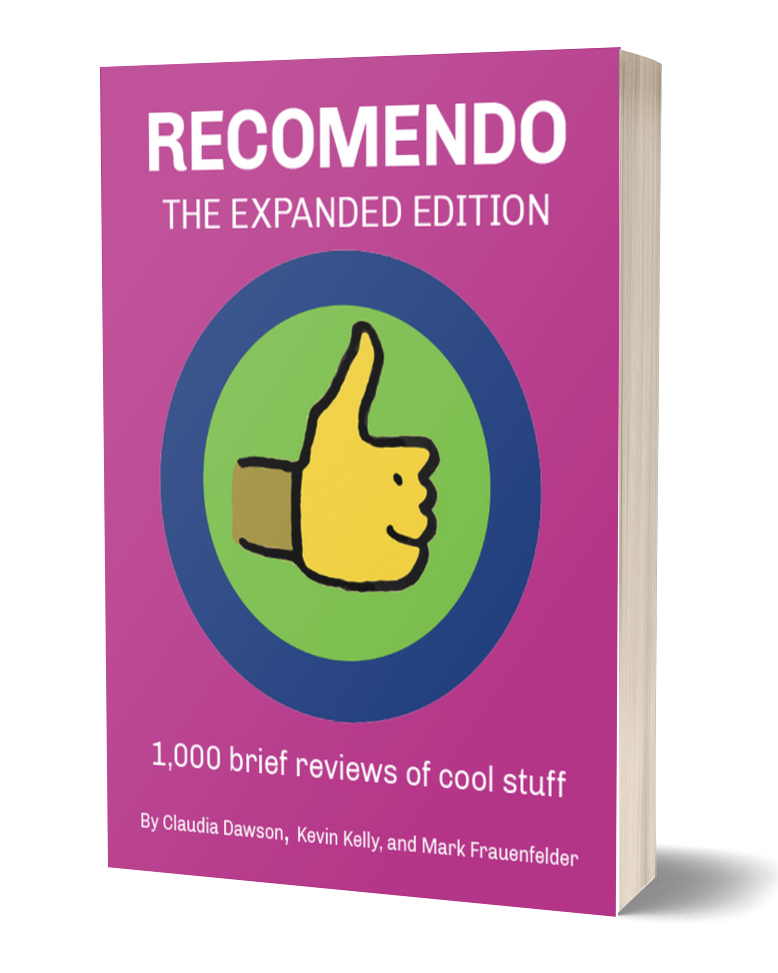Reliable Vehicles
Tools for Possibilities: issue no. 113
Once a week we’ll send out a page from Cool Tools: A Catalog of Possibilities. The tools might be outdated or obsolete, and the links to them may or may not work. We present these vintage recommendations as is because the possibilities they inspire are new. Sign up here to get Tools for Possibilities a week early in your inbox.

The people’s truck
Because I’ve worked for years at the edges of computer research, and have grown accustomed to flakey and fragile gadgets that only work intermittently, then crash, I have for my private life adopted a farmer’s’ frugal aesthetic when selecting durable tools. I favor poet Gary Synder’s measure of dependability*:
I lie in the dusty and broken brush
Under the pickup
Already thought to be old –
Admiring its solidness, square lines
Thinking a truck like this
Would please Chairman Mao
My own people’s pickup is a 1996 4-cylinder Toyota Tacoma 4×4 with 110,00 miles. Toyota pickups were widely visible during CNN coverage of the middle east as the vehicle of choice in the rugged mountains of Afghanistan, and Pakistan. Indeed you find these almost anywhere in the world where reliability is difficult but critical. My mechanic for years, an expatriate Iranian, says that every mechanic he knows admires, and many own, the Toyota 4 cylinder trucks for their durability and reliability.
I use mine to haul feed for the animals, to clear brush from the pastures, to haul firewood, to traverse the high country through deep snow, and for regular commuting over mountain roads and congested freeways. Despite only 4 cylinders, power is ample for any use on or off-road. A used Toyota like mine would sell for $6,000. But I’m pleased to see that prices for a new one are about the same as I paid in ’96: dealers sticker is under $18,000, retail around $19,000. The basic four cylinder engine is unchanged throughout the years. It’s a classic, like the old GMC/Chevy straight six, and the Dodge slant six; only the running gear and comforts are improved.
It is a truck, I bet, that would have pleased Chairman Mao. — Mike Liebhold
Toyota is well known around the world for its durability. Mike Liebhold mentions Afghanistan, Iraq and Pakistan and other notorious places where Toyotas reign. In fact the United Nations uses a Toyota fleet for its peace keepers and observers around the world. Most don’t realize they are using Toyotas that are not available in the USA due to lower emissions standards. The Toyotas you see NGOs using are made by a special unit of Toyota called Gibraltar. They have SUVs, Pickups, etc.. same lines as you’d find at dealers but different models and configurations. My favorite option is the ballistic mat. It’s an explosion-proof padding that goes underneath the carpet in case of landmines.
I just spent the past 8 weeks on a “vehicle dependent expedition” in the deserts of Nevada in a Toyota 4Runner with no mechanical breakdowns (other than flats). It really is wonderful engineering. However, it is not always the best tool for the job. Toyotas are rock solid but they do wear out and when on an extended trip you want a vehicle that is easy to maintain in the field. Toyotas are good for short and medium term trips where breakdown is hopefully not going to happen, for long-term expeditions where breakdown is inevitable, you want something that is fully self-sufficient.
For example, on an extended African trip you won’t find a certified Toyota mechanic and parts everywhere. Older Land Rovers are often a better choice because they are essentially fully repairable in the field. Everything is bolted on and can easily be swapped out. Like the windshields come off with a few bolts. Fixing a windshield in a Toyota is more involved and complicated . With a Land Rover it’s possible to bring all spare parts and keep the vehicle going indefinitely with no outside help short of catastrophic damage.
To sum up: Toyotas are more modern design using newer technology; the older Land Rovers are basic nuts and bolts. The Land Rover will probably break down more often, but be easier to fix. Land Rovers are kind of like the hackers’ vehicle, an old PC running Linux, while the Toyota is more like a Macintosh, well designed and reliable.— Stephen Balbach
I have owned three Toyota 4-cyl. 4×4’s over the years, but the basic unit is the same.
I had an ’88 that I put about 170 K miles on. In 14 years it never failed to start up (except once when the starter motor went out). I went through arroyos, all over the desert, on beaches with soft sand. I pulled people out of ditches. It was also my city vehicle. I sold it last year to a surfer dude for about $1500. The only thing wrong was that the body was pretty completely rusted out, since I live on the ocean (and also I figured in retrospect because I would never rinse it off after hauling surfboards dripping with salt water).
Then I bought a 2003 and it’s a dream. Toyota has re-thought every part of it, and redesigned where necessary. The radio, the wipers, the seats, the exterior and interior design.
There’s an old Yakima rocket box on the top, and the cylindrical thing is a pull-out tarp for quick shade that I got used . Note the metal camper window on the drivers side (where you don’t need visibility). — Lloyd Kahn

Superior compact
I’ve been driving 4×4 trucks for over 30 years. The tradeoff for the weight and truckiness being that I could pick up firewood, haul lumber and sacks of concrete, and go anywhere, any time. I spent 12 years 4-wheeling in Baja. Three long trips to British Columbia. 4-wheeling it across the river to my friend Louie’s house in Mendocino county. I’ve been a truck guy forever.
But there came the time, several months ago, when I realized I was through with the long truck hauls, the 3,000-mile trips, and hauling the truck over the windy roads homewards from my weekly trips into San Francisco was a chore.
I embarked on a study of cars, and ended up settling on a Honda Fit. Other contenders (in this field of scaled-down, aerodynamic SUVs) were the Toyota Yaris Liftback, Mazda 2, Scion XD, Prius C model, VW Golf diesel. The Cube too cartoony, the Scion xB too boxy. In the end I settled on the Fit largely because of its ingenious cargo space in the rear: 4 x 5 feet with rear seats folded down. 20 cubic feet of space vs. 15 for the other cars. 4 doors and a hatchback so you can get into the rear from all sides. Like a small truck bed. (I could get into my truck bed camper shell on all 3 sides.)
I guess things have come a long way, because this very efficient little car reminds me of going from a truck to this car is like going from logging boots to running shoes. Like a 250 pound guy losing 60 pounds.
360-degree visibility, automatic windows, a USB connector. There are a dozen things that delight me about this car. I could drive all day and arrive rested. I’m in auto heaven. — Lloyd Kahn

Cheapest reliable used car
The Volvo 240 series of cars is quite possibly one of the best used car deals for the cooltools crowd. They were made from 1975 until 1993 — so there are plenty of them to go around. In fact, Volvo wanted to stop making the cars three years before they actually stop producing them — the community demand was so great they just didn’t stop!
240s are roomy (especially in wagon form), reasonably fuel efficient (20 – 30 mpg), durable (engines with 200,000+ miles are not blinked at), solid (steel construction), safe (one of the many cars that built the Volvo=Safe reputation), comfy (lumbar support, heated seats, et cetera), simple to work on (thanks to a roomy engine bay), excellent community support (comprehensive FAQ & online forums), excellent parts support (online junkyard parts galore, and you can still get parts at dealerships), good in the winter (with proper snow tires) and best of all, cheap! A 240 in good condition can be had for anywhere from free (it needs a little work and it’s so old and has so many miles… who’d want it?) to $2,000+ for a well looked after example. (The 240’s latter siblings, the 740 and 940, are both fine cars as well – based on the same mechanicals as the 240)
I’ve had two previous Vovlo 240s and love my current 1990 240 wagon. I purchased it with 225,000 miles already on the odometer for a trip to Alaska. It may be a 16 year old car, but it brings a smile to my face. — Zach Zaletel
11/25/24





